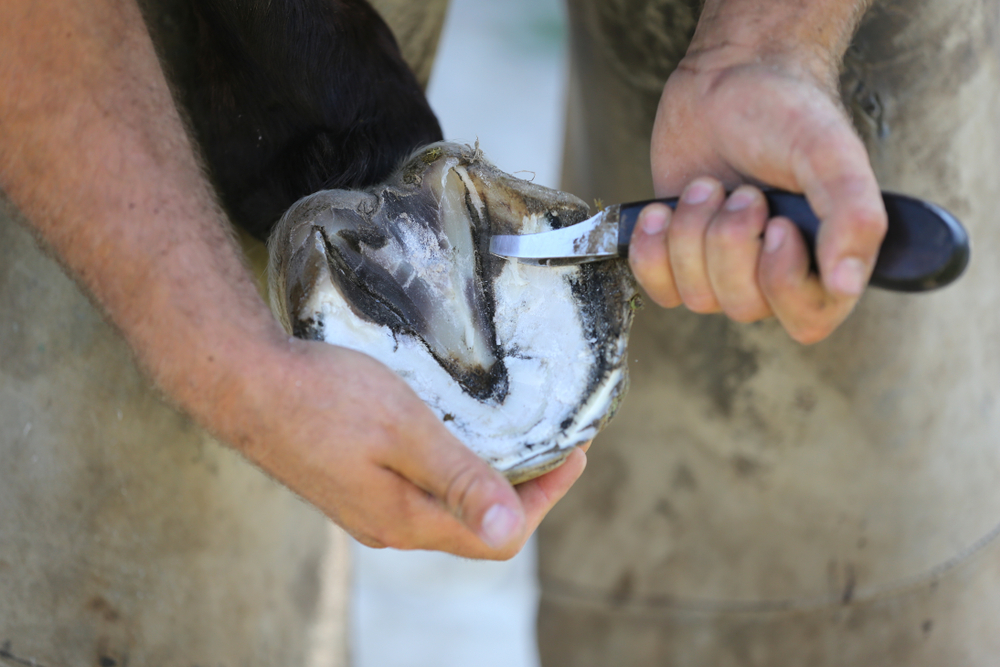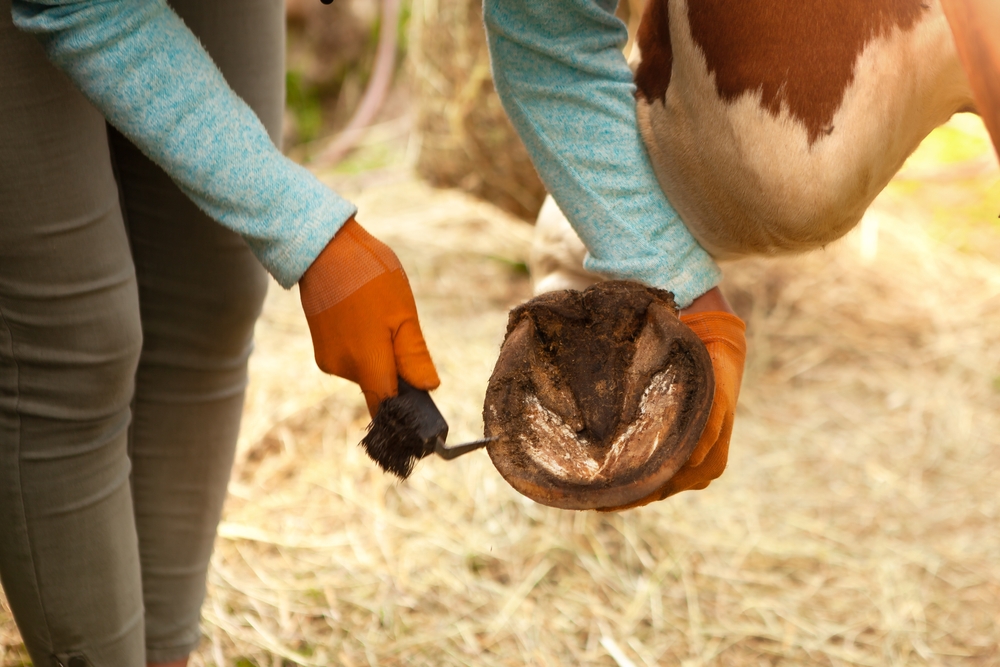Whinny’s Wisdoms
 As the Clinic Mouse, I’m pretty good at seeing things around the clinic (but not being seen–being a mouse has its advantages!). But I am best at seeing things closer to my eyeline… and I’m all about horse feet. The doctors here at Springhill Equine pay special attention to their patients’ hooves because they are so important and can cause oh so many things to go wrong if not cared for properly.
As the Clinic Mouse, I’m pretty good at seeing things around the clinic (but not being seen–being a mouse has its advantages!). But I am best at seeing things closer to my eyeline… and I’m all about horse feet. The doctors here at Springhill Equine pay special attention to their patients’ hooves because they are so important and can cause oh so many things to go wrong if not cared for properly.
The most expert of all the experts on horse feet is Dr. Staples. She’s an equine podiatrist, which means she’s a veterinarian, and certified journeyman farrier. We’re very fortunate to have her in our corner of the world!
Whinny Wisdom: Podiatry is a branch of medicine dedicated to diagnosing and managing conditions affecting the foot.
Dr. Staples says that horses with abscesses are acutely lame on just a single foot. While there can be multiple causes for a single-leg lameness, abscess is always high on the list! Tony (the best kitty mentor a mouse could ask for) says that “abscesses usually make their presence very well known.” In fact, I hear it’s not unusual for a human to call in saying they think their horse has broken their leg, but when our team gets out there it’s just a foot abscess! I’ve used that word a lot, so I should define it, huh?
An abscess is basically just a pocket of pus. Pus is a collection of immune cells, dead tissue, and bacteria. Abscesses can form anywhere in the body, but they love to form when a bit of bacteria sneak their way in between the hard hoof wall and the soft inner tissues of the foot. They can also form if your horse steps on something and sustains a small puncture wound which allows bacteria in. It always amazes me how much you humans miss being up there–the ground around horses is often hiding little nails, metal pieces, or other things that can injure your horse (or mouse!).

When abscesses occur under the skin due to injury, there is usually room for the skin and surrounding tissues to expand and swell. The veterinarians and technicians here at Springhill all get very excited when they get to “pop” one of these big swellings! But in the hoof, there’s a hard outer covering preventing major swelling. Still, the way to make the pain go away is to establish drainage. When the horses are lucky, that drainage happens out the bottom of the foot, but sometimes it comes out the top, near the coronet band.
The best thing you as the human can do to help your horse once it’s been diagnosed with an abscess is help to promote drainage. The doctors like to use epsom salts as a drawing agent. They even have a video to show you how use a baby diaper and secure it to your horse’s foot. Alternatively, you can soak your horse’s foot in warm water with epsom salts a few times per day. Usually I see ground feeders or other small buckets used for this–just once I wish they’d fill one up for me to have a little mousey soak without a giant horse hoof in the way.
So, let’s say you call the clinic to send a doctor out for your horse’s acute, non-weight bearing lameness. Let me talk about what you’ll see happen. First, they’ll ask you all about when you first noticed it, if you’ve given your horse any medications (don’t do this without asking first!), and if he’s ever had any hoof issues before. They might ask about when the last time the farrier was there too. Then, they’ll likely take a look and a feel of the leg and the hoof.
You may see them examine more legs than the one you think is the problem, and there’s a few reasons for that. It’s always easiest to tell what abnormal is when it is compared to normal, so the doctors may do a lot of compare and contrast of the different legs to help determine the cause. You’ll likely see them bring a hoofpick and a big, barbaric looking tool called a hoof tester. Hoof testers are used to apply pressure to specific spots around the hoof to look for reaction or pain.
Depending on how obvious the lameness is, the doctor may need to see the horse walk or trot, or they may perform diagnostic local anesthesia to isolate the problem to the hoof. If your horse has a very obvious soft or painful spot, the doctor may take a hoof knife and gently and carefully remove some sole. It’s very easy to do more harm than good with this, so it’s a strictly DVM endeavor.
Often, our veterinarians will need to take radiographs–otherwise known as x-rays–of your horse’s foot to look for the abscess location.
Whinny Wisdom: X-rays involve taking a 2-D image of a 3-D structure, so at least two views are always needed. Often 3 or more views are needed to see the problem in all planes and get an exact location.
Sometimes the doctor needs to sedate or even block the foot just to take those x-rays because the horse is so painful. But once they can find the location, they can give you a better idea of how long you’ll need to treat. And as Tony says, the good news with abscesses is that, almost always, once they are opened and drained, your horse will return to being happy and comfortable. He may be a cat, but even I have to admit he’s right most of the time. In addition to the diaper and/or soaking treatments, our team will likely put your horse on pain medication. The pain medication not only helps them feel better, but also encourages them to put full weight on the problem hoof, thereby squishing out the abscess.

So how do you prevent hoof abscesses? Well, you can’t prevent all of them, but regular trimming by an experienced farrier is a good start. In between trims, you should clean your horse’s feet every day with a hoof pick. And keep a close eye at mouse-level around your barn for nails, screws, or any other possible puncture risks. Any time your horse is lame, give the clinic a call and let us get you an appointment to figure out why.
That’s it for this week!
~Whinny
P.S. Are you subscribed to my blog? If not, there’s a big purple box just below where you can sign up! Don’t rely on Facebook to tell you when my newest blog is out, get it right in your email!
 Whinny’s Wisdoms is the official blog of Whinny the Clinic Mouse at Springhill Equine Veterinary Clinic in Newberry, Florida. If you liked this blog, please subscribe below, and share it with your friends on social media! For more information, please call us at (352) 472-1620, visit our website at SpringhillEquine.com, or follow us on Facebook!
Whinny’s Wisdoms is the official blog of Whinny the Clinic Mouse at Springhill Equine Veterinary Clinic in Newberry, Florida. If you liked this blog, please subscribe below, and share it with your friends on social media! For more information, please call us at (352) 472-1620, visit our website at SpringhillEquine.com, or follow us on Facebook!
[jetpack_subscription_form title="Subscribe to Whinny's Wisdoms"]

